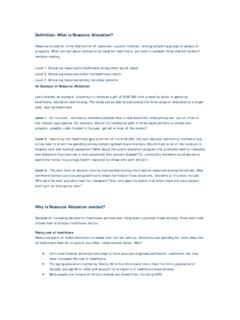Transcription of Diabetes: What is the scope of the problem?
1 Diabetes: What is the scope of the problem ?Elizabeth R. Seaquist MD Division of Endocrinology and DiabetesDepartment of MedicineDirector, General Clinical Research CenterPennock Family Chair in Diabetes ResearchUniversity of MinnesotaDiabetes MellitusA disorder of glucose metabolism resulting in hyperglycemia as a result of insulin deficiency or abnormal insulin secretion and action. Shortens average Shortens average life expectancy life expectancy by up to 15 yearsby up to 15 yearsEspecially prevalent in Especially prevalent in African and Hispanic African and Hispanic AmericansAmericansImpact of Type 1 and Type 2 DiabetesDiabetesDiabetes6th leading 6th leading cause of death cause of death Adapted from #contents. Accessed 2/10 Research Working Group. NIH Pub #99-4398;1999:1 Individuals diagnoseddiagnosed million each million each yearyearIncreasingly Increasingly affects all age affects all age groupsgroupsSource: Mokdad et al.
2 , Diabetes Care 2000;23:1278-83; J Am Med Assoc 2001;286:10 .Diabetes Trends* Among Adults in the ,(Includes Gestational Diabetes)BRFSS, 1990,1995 and 2001199019952001No Data <4% 4-6% 6-8% 8-10% >10%051015202530 White maleWhitefemaleBlack male Black femaleHispanicmaleHispanicfemalePrevalen ce per 100 people0-4445-6465-74>752002 Diabetes prevalence in US by age, gender, raceCDCType 2 diabetes90-95%Type 1 diabetes5-10%Other1-2%Gestational diabetes3-5%Type 1 Diabetes MellitusInsulin Dependent Diabetes Mellitus (IDDM), Type I Diabetes, Ketosis-prone diabetes, Juvenile onset diabetes mellitus Caused by an absolute deficiency of insulin Occurs because of autoimmune destruction of pancreatic beta cells Arises in genetically susceptible individuals exposed to a triggering factorType 1 diabetes Peak time of clinical onset is at puberty but can present at any age Patients are usually lean Concordance rate for identical twins is ~50% Insulin therapy is required for survivalType 2 Diabetes MellitusNon-insulin dependent diabetes mellitus (NIDDM), Adult onset diabetes mellitus Occurs because of a defect in both insulin secretion and insulin action Primary defect probably varies by population but failure to compensate for primary defect ultimately leads to hyperglycemiaCopyright 2006 American Society for Clinical InvestigationPrentki, M.
3 Et al. J. Clin. Invest. 2006;116:1802-1812 Type 2 diabetes Usually presents in adulthood Patients are usually obese at presentation Concordance rate for identical wins is >90% Long prodrome (period of impaired glucose intolerance) often undetected Long-term complications may be present at time of diagnosisHarris MI. Clin Invest Med 1995;18:231-239 Nelson RG et al. Adv Nephrol Necker Hosp 1995;24:145-156 World Health Organization, 2002;Fact Sheet N 138 Diabetic RetinopathyMicrovascular ComplicationsMacrovascular ComplicationsDiabetic ComplicationsDiabetic NephropathyDiabetic NeuropathyStrokePeripheralVascular DiseaseHeartDiseaseEffect of Glycemic Control on Incidence of Diabetic Complications in Patients With Type 1 Diabetes-60-40-20020406080100 Conventional Therapy Intensive Therapy Difference Between TherapiesData derived from Rathmann W. Drug Benefit Trends.
4 1998;24 33. Estimated Lifetime Cumulative IncidencesProliferativeBlindnessMicroalb uminuriaAlbuminuriaEnd-stage renal diseaseNeuropathyNephropathyRetinopathyN europathyFoodExerciseGlucose ControlDrugsHirsch I. N Engl J Med 2005;352:174-183 Usual sequence of interventions0 4 7 10 16 20 DietOralAgentsCombinationTherapy withOral agentsInsulinUsualClinicalCourseYearOnse t ofDiabetesDiagnosisDevelopment ofcomplicationsDeathTypical course for type 2 diabetesGlucose uptake by muscles2,4 Role of Incretins in Glucose HomeostasisDPP-4 = dipeptidyl-peptidase 41. Kieffer TJ, Habener JF. Endocr Rev. 1999;20:876 Ahr n B. Curr Diab Rep. 2003;2:365 Drucker DJ. Diabetes Care. 2003;26:2929 Holst JJ. Diabetes Metab Res Rev. 2002;18:430 of foodBeta cellsAlpha cellsRelease of gut hormones Incretins1,2 Pancreas2,3 Glucose-dependent Insulin from beta cells(GLP-1 and GIP)Glucose production by liverBlood glucoseGlucose dependent Glucagon fromalpha cells(GLP-1)GI tractActiveGLP-1 & GIPDPP-4 enzymeInactive GIPI nactive GLP-1 Incretin therapies GLP-1 analog (Exenatide)Administered twice daily by subcutaneous injectionLowers A1c effects are weight loss, nausea, hypoglycemia DPP-1 inhibitors (vitagliptin, sidagliptin)Orally administered once a dayLowers A1c by ~ associated with weight loss or nauseaEconomic Consequences of Diabetes in the United StatesIndirect Costs:Indirect Costs: $40 Billion$40 BillionAnnual Total: $132 Billion*Annual Total: $132 Billion*Indirect costs due to disability and early mortality:$40 billion*Approximate 2002 US DollarsDiabetes/diabetes supplies.
5 $23 billionDirect Costs:Direct Costs: $92 Billion$92 BillionExcess prevalence of general medical conditions:$44 billionExcessprevalence of chronic complications:$25 billion$25 billionHogan P, et al. Diabetes Care. 2003;26:917 Per Capita Health Care Expenditure 200213,2432,56002,0004,0006,0008,00010,0 0012,00014,000$Diabetes Without DiabetesADA. Diabetes Care. 2003;26:917 932.
















